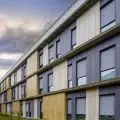Today's cities are facing the challenges of climate change. In response to these issues, the concept of blue-green infrastructure is gaining traction, offering solutions that integrate natural elements into the urban fabric. Particularly during the summer, when cities face heat waves, the role of blue-green infrastructure becomes crucial.
Mid-June 2024 - weather forecast for the next few days - up to 33 degrees. It's going to be tough, especially since it's only the beginning of summer. The RCB Alert has been warning of thunderstorms for several weeks now. While quite a few people complain that the text messages are sent too often and the warnings don't work, I think they are important. With the changing climate, the nature of precipitation is changing. In the past, when a storm was coming, the air thickened and steel clouds appeared in the sky, the storm was coupled with rain.
On May 20, a gigantic downpour swept through Gniezno. Within an hour, 60 to 80 mm of rain fell on the city, more than the monthly norm for May. The city's landscape was dramatically altered, and the damage was so severe that the army's assistance was required. Four days later, a downpour of several minutes turned the streets of Ostrow Wielkopolski into rivers[1]. Cars had trouble getting around, pedestrians were wading in water, and it overflowed from the sidewalks into the streets. Sewer manholes were unable to receive such a large amount of water that fell from the sky in an instant - about 23 l/m2 fell in just a quarter of an hour. In early June in Malopolska as a result of torrential rains, many properties and streets were flooded, especially in Krakow and Olkusz[2]. In the Silesian province, the highest, third level of danger from thunderstorms and rainfall was in effect, and the mayor of Bielsko-Biała declared a flood alert[3]. Many roads, properties and buildings were flooded. On June 16, meanwhile, firefighters from the Elblag City Fire Department had their hands full. All because of a torrential downpour that caused local flooding[4].
Climate change is affecting the structure of precipitation, as is evident in a report on changes in temperature and precipitation across Poland by 2100 [5]. Although the sum of annual precipitation in Poland does not change significantly, the frequency of precipitation is decreasing - it rains less frequently, but definitely more intensively. This leads to more frequent and violent flash floods.
Cities that are concreted, channelized and devoid of greenery are not prepared for such intense precipitation. Water evaporates from these areas much faster, causing scarcity and unavailability for plants. Climate change and the poor state of water infrastructure mean that we are not ready for extreme weather events, which are becoming more frequent.
The Institute of Meteorology and Water Management's report "Characteristics of Selected Climate Elements in Poland in 2023" shows that last year was extremely warm. Extreme weather phenomena, which used to happen once every 50-100 years, now occur up to a dozen times more often. Many of these phenomena are unpredictable and make it difficult to prepare for them. This leads to deeper droughts, affecting water availability. This year we have already had 118 appeals to reduce water consumption[6].
what is blue-green infrastructure?
Blue-green infrastructure refers to a system that combines water (blue) and green (vegetation) elements to improve the quality of life for residents, adapt to climate change and increase biodiversity. It includes parks, rain gardens, green roofs, green walls, retention ponds and other solutions that support water retention processes.
On hot days, the urban heat island effect causes cities to heat up more than rural areas. Blue-green infrastructure can significantly reduce this effect. First of all, it contributes to cooling the air. Vegetation and water reduce ambient temperatures through transpiration - the active evaporation of water from plants, mainly from tree leaves, but also from branches and trunk. Trees take moisture from the soil, transport it to the leaves, where it is released into the atmosphere as water vapor. This vapor absorbs the heat necessary to change its state of aggregation from liquid to gas, which leads to the cooling of the tree and the surrounding air. The cooler air then descends to the level of streets and squares, bringing relief on hot days. Trees and other forms of vegetation, such as shrubs and tall grasses, lower surface and air temperatures, providing shade and cooling through evapotranspiration. Studies have shown that temperatures in urban forests are as much as 15°C lower than in urban areas without trees[7].
During periods of heavy rainfall, especially during summer storms, blue-green infrastructure helps with water retention and infiltration, reducing the risk of flooding and overloading sewer systems. It consists of elements such as green roofs, rain gardens, retention basins, ponds and infiltration systems that support natural water absorption and storage processes. As a result, rainwater is effectively retained and slowly released into the soil, reducing the risk of flooding and overloading sewer systems.
These solutions not only protect against flooding of streets and buildings, but also improve surface water quality by naturally filtering pollutants. In addition, blue-green infrastructure supports biodiversity by creating habitats for a variety of plant and animal species. As a result, cities and villages become more resilient to extreme weather events, while also contributing to an improved quality of life.
In addition, air quality improves thanks to the expansion of the green network. Vegetation filters the air, absorbing pollutants and releasing oxygen. This reduces pollutants and improves overall air quality, which is especially important on summer days with low air circulation.
Blue-green infrastructure is of great importance to various social groups that are particularly vulnerable to the negative effects of urban climate change, especially the elderly and children. It is these groups that are the most vulnerable, and they are the ones who can be harmed the most by heat waves[8]. Blue-green infrastructure provides cooler and healthier living conditions, reducing the risk of heat stroke and respiratory diseases.
a handful of ideas
The Vauban district in Freiburg is an example of a revitalized brownfield site with limited car access and abundant green space. The streetcar line has a green track, which helps reduce noise and air pollution and improves rainwater management. Rainwater is collected in retention ditches so that it can effectively soak into the ground and reduce the load on the local stream.
Gdansk has made a number of changes to implement rainwater management solutions. The goal of the Greening Policy there is based on the creation of a coherent blue-green infrastructure management policy. The designated measures focus on multi-level implementation of ideas in various locations - from city-wide parks, neighborhood green spaces and squares, to community gardens and micro-retention on buildings[9].
In the capital, a program called "Warsaw Grabs Water" was launched, under which residents could receive a subsidy for the construction of facilities to retain and use rainwater and snowmelt on site. Subsidies could be obtained for the construction of retention and drainage devices (e.g., drainage boxes and absorption wells) and retention tanks.[10]
Lodz has been consistently implementing blue-green infrastructure solutions. In the Lodz province, which is particularly prone to the problem of drought, the Provincial Fund for Environmental Protection and Water Management in Lodz has allocated PLN 4 million to subsidize retention under the priority program "Rainwater - Rainwater Harvesting." The first priority here is to create, protect and properly use natural potential. Secondarily, thought is given to minimizing the negative impact that the investments carried out in the city have on people's lives. As a last resort, only compensation or repair of the negative impact of investments on society or the environment is considered[11]. Thanks to public programs, interested people can also obtain funding for sowing flower meadows and building small retention reservoirs.
Finally, it is worth mentioning that it is the small retention reservoirs that are a great part of the blue-green infrastructure. Fed by rainwater, snowmelt or groundwater, they are a source of water that, seeping into the soil, irrigates the surrounding areas. Thanks to simplified procedures, anyone can make such a pond without a water permit[12]. The construction of such a reservoir can be partially financed with funds offered by both local governments and government institutions.
Blue-green infrastructure is an indispensable part of a modern city in the era of climate change. Its importance grows especially during the summer, when the effects of the urban heat island are felt the most. The integration of natural elements into urban space significantly improves the quality of life for residents, sometimes even enabling them to survive hot weather or protect their possessions from flooding.
Magdalena Milert
[1] https://wlkp24.info/ostrow-zalany-wystarczylo-kilka-minut-deszczu-wideo-zdjecia-aktualizacje/
[2] https://www.portalsamorzadowy.pl/wydarzenia-lokalne/podtopienia-w-malopolsce-trudna-sytuacja-w-krakowie-i-olkuszu,548389.html
[3] https://wydarzenia.interia.pl/tylko-w-interii/news-obudzila-ich-potezna-burza-tego-sie-nie-spodziewali-woda-cal,nId,7553581
[4] https://www.expresselblag.pl/artykul/17334,podtopienia-zalane-piwnice-po-ulewie-w-elblagu-foto
[5] https://klimada2.ios.gov.pl/files/2021/RAPORT_Zmiany%20temperatury%20i%20opadu.pdf
[6] https://swiatwody.blog/2022/10/31/wysychajaca-polska-zmiana-bilansu-opad-parowanie/
[7] https://www.epa.gov/heatislands/using-trees-and-vegetation-reduce-heat-islands
[8] Cities, architecture and silver tsunami, A&B 06.2024 https://www.architekturaibiznes.pl/508,architekturaibiznes-06-2024.html
[9] https://www.brg.gda.pl/aktualnosci/gdanska-polityka-zieleni/1798-gdanska-polityka-zieleni-idea-rozwoju-blekitno-zielonej-infrastruktury
[10] https://www.gov.pl/web/retencja/blekitno-zielona-infrastruktura-dlaczego-jest-tak-wazna-dla-retencji
[11] Janasz, M., & Kaluzynski, P. (2018). Green infrastructure as a challenge for urban logistics. In Different faces of logistics. A collection of student papers;. University of Lodz Publishing House.
[12] According to Article 394, paragraph 1, item 9 of the Water Law (Journal of Laws 2020, item 310), water reservoirs - ponds - filled exclusively with rainwater or snowmelt or groundwater with an area not exceeding 1,000 m2 and a depth not exceeding 3 m from the natural surface of the land with a range of impact not exceeding the boundaries of the land owned by the owner, may be carried out on the basis of a simplified procedure of water law consent - water law notification.




![Fuhimiko Maki [ur. 6 września 1928 w Tokio, zm. 6 czerwca 2024]](https://cdn.architekturaibiznes.pl/upload/cms_aktualnosci/34675/images/kadr19/fit/560x560/fuhimiko-maki-ur-wrzesnia-w-tokio-zm-czerwca-416547.jpg)









